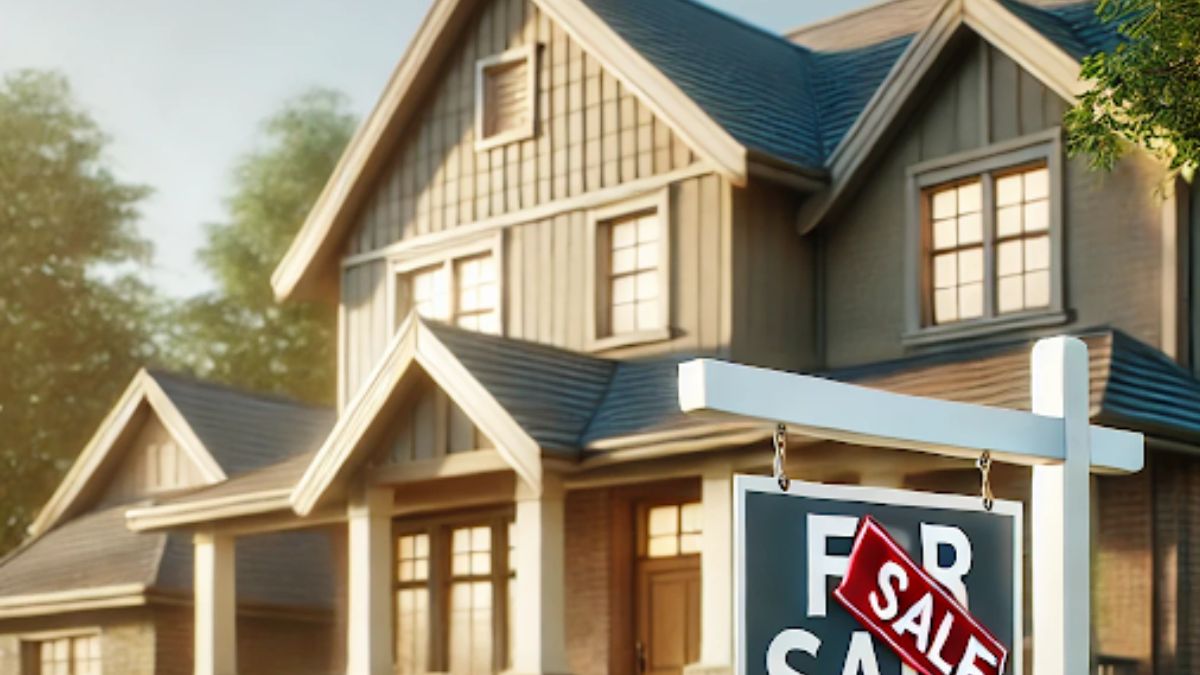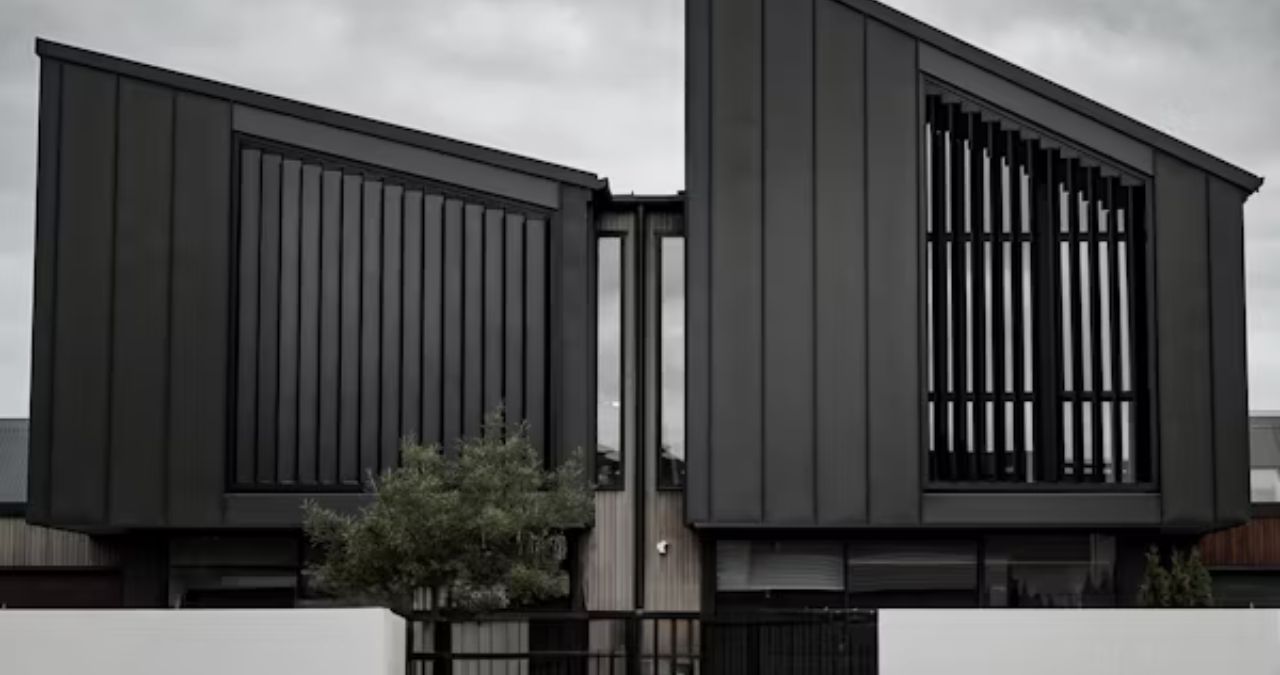REAL ESTATE
The Ultimate Guide to Selling Your Home in a Competitive Market

Selling a home is a significant decision, and in today’s ever-changing real estate landscape, it’s essential to be equipped with the right strategies to get the best value for your property. Whether you’re a first-time seller or an experienced homeowner looking to move, understanding the nuances of selling in a competitive market can make a difference.
This guide will help you follow the essential steps to selling your home quickly and efficiently while maximizing your profits.
-
Timing Is Key: When Is the Best Time to Sell?
One of the most important factors when selling a home is timing. While spring and summer are typically peak seasons for real estate transactions, market conditions may shift this norm. Understanding local and national market trends can give you a clear advantage.
For example, in recent years, low mortgage rates have extended buying activity well into fall and winter. Monitoring mortgage trends, economic shifts, and local real estate cycles can help you pinpoint the perfect time to sell your home for top dollar.
Key Tip:
Consider working with a real estate agent or professional who can provide market insights specific to your area. They can analyze local trends to help you decide when to list.
-
Prepare Your Home for Today’s Buyers
Buyers have become more discerning in the digital age. With most home searches starting online, your property must make a solid first impression.
Curb Appeal
The first thing a potential buyer sees is your home’s exterior. Improving your curb appeal doesn’t have to break the bank. Simple updates like a fresh coat of paint on the front door, well-maintained landscaping, and clean walkways can make your home more inviting.
Declutter and Stage
Once inside, buyers want to imagine themselves living in the space. Decluttering and staging your home effectively can make rooms feel more spacious and functional. Consider hiring a professional stager or, at the very least, rearrange furniture to open up spaces and enhance flow.
Upgrades and Repairs
Address any minor repairs before listing. While some buyers may be willing to purchase a home that needs a little work, most are looking for properties that are move-in ready. Minor upgrades, like updating outdated lighting fixtures or refreshing the kitchen with modern hardware, can significantly impact the kitchen.
Pro Tip:
If your home requires significant repairs and you don’t have the time or budget to address them, selling to a cash home buyer might be a viable option. This allows you to sell your home as-is without the hassle of extensive repairs.
-
Pricing Your Home Strategically
Pricing is one of the most critical decisions you’ll make when selling your home. Price it too high, and your home may sit on the market for months; price it too low, and you might leave money on the table.
To determine the right price, consider:
-
Comparable Sales (Comps): Look at recent sales of similar homes in your neighborhood.
-
Current Market Conditions: In a seller’s market, you may be able to price your home more aggressively, while in a buyer’s market, competitive pricing is critical to attracting offers.
-
Buyer Psychology: Pricing slightly below a critical threshold (e.g., $399,000 instead of $405,000) can attract more attention and potentially drive a bidding war.
When pricing your home, working with a real estate agent who understands local market dynamics can be constructive.
-
Leverage Technology for Maximum Exposure
In today’s digital age, buyers begin their home search online. As a seller, this presents a huge opportunity to showcase your home in the best possible light through high-quality photography, video tours, and virtual open houses.
Professional Photography
Investing in professional photography is essential. High-quality photos can make your home stand out in a crowded market. Before the photoshoot, ensure that every room is well-lit and clean.
Virtual Tours and 3D Walkthroughs
With the rise of remote work and virtual home buying, 3D walkthroughs and virtual tours have become incredibly popular. These tools allow potential buyers to explore your home from the comfort of their living room, expanding your buyer pool beyond local markets.
Utilize Social Media
Remember to underestimate the power of social media in real estate. Promoting your listing on platforms like Instagram, Facebook, and Pinterest can generate buzz and attract a wider audience.
-
Be Flexible with Showings and Offers
In a competitive market, flexibility can make all the difference. Being open to showings at various times of the day (including evenings and weekends) increases the likelihood of getting an offer.
Additionally, be prepared to review multiple offers. In a hot market, bidding wars can occur, driving up the price. However, it’s important not to focus solely on the price—consider other terms such as contingencies, closing timeline, and buyer financing.
-
The Role of Negotiation in a Successful Sale
Once you receive an offer, negotiation plays a critical role in finalizing the sale. Here are a few things to keep in mind:
-
Counteroffers: Feel free to make a counteroffer if the initial offer isn’t satisfactory. This could involve negotiating on the price, contingencies, or timeline.
-
Be Objective: While selling a home can be emotional, it’s essential to remain objective during negotiations. Focus on the end goal and work with your agent to reach a fair deal.
-
Closing the Deal
Once you’ve agreed on terms, the closing process begins. This typically includes:
-
Home Inspection: The buyer will likely schedule a home inspection to ensure no hidden issues. Be prepared to address any problems that arise.
-
Appraisal: If the buyer is financing the purchase, the lender will require an assessment to ensure the home’s value matches the loan amount.
-
Final Walkthrough: The buyer will complete a final walkthrough to confirm that the home is in the agreed-upon condition.
Once these steps are completed, you’ll sign the necessary paperwork and hand over the keys, and the sale will be finalized.

Conclusion: Is Selling Your Home the Right Choice Now?
The decision to sell your home is both personal and financial. Understanding the current real estate market, preparing your home for buyers, and leveraging the right marketing strategies can increase your chances of a successful sale.
Other options are available for homeowners looking for a quicker and less conventional sale. If you want to sell your home without the hassle of repairs, staging, or waiting for a buyer, consider exploring companies that purchase homes for cash.
One such option is Cinch Home Buyers, a trusted service that offers fast, hassle-free cash for homes in any condition. This can be an excellent solution for homeowners who need to sell quickly or don’t want to invest in home improvements before selling.
REAL ESTATE
Modern Fence Design Ideas For Residential Properties

How Fencing Can Transform The Look Of A Home
A thoughtfully chosen and skillfully installed fence can completely redefine a property’s appearance and atmosphere. While fences traditionally provided essential privacy and security, today’s residential designs transform these boundaries into intentional style statements. A well-integrated fence complements the home’s architecture, not only enhancing the landscaping but also serving as a framework that enhances the overall visual impact of the yard and entryway. Properties with attractive, well-kept fencing are known to enjoy increased curb appeal, and real estate industry data highlights how these visual elements can add as much as 5% to a home’s value. Seeking advice from an experienced fence company Houston, TX, can help identify a balance between style and function, ensuring the finished product not only looks appealing but also meets specific privacy and security requirements.
The look of a fence—whether it’s a modern horizontal design or a classic picket—frames how guests and potential buyers perceive your property. Front yard fences can signal hospitality and order, while stylish backyard enclosures can create private, cozy retreats for family gatherings and relaxation. Well-planned fences also highlight elegant plantings or distinctive architecture, pulling the entire outdoor space together. Investing in a distinctive fence design is not just about visual impact; it’s about elevating the everyday living experience and making a lasting impression.
Popular Materials And Their Pros & Cons
The choice of fencing materials is a crucial factor that affects both appearance and longevity, as well as long-term maintenance. Each material offers unique benefits and challenges, and understanding these can help homeowners make informed decisions. Wood remains a top choice due to its natural warmth and flexibility—it’s easy to install, can be painted or stained in an endless array of shades, and adds undeniable charm to both modern and traditional spaces. Cedar and redwood, in particular, are favored for their durability and resistance to rot; however, even the toughest woods will eventually require treatments to protect them from weather and pests.
- Wood: Ideal for a custom look but requires staining or sealing every few years. It can be prone to warping in humid climates.
- Vinyl: Gaining popularity among busy homeowners, vinyl fencing boasts impressive durability and requires virtually no maintenance. Unlike wood, it won’t fade, splinter, or require repainting. On the downside, vinyl is less eco-friendly and more susceptible to cracking when exposed to temperature swings.
- Metal (Aluminum, Steel, Wrought Iron): For a sleek, secure look, metals stand out. While aluminum resists rust and is lightweight, steel and wrought iron can last for generations if maintained. These materials excel in custom designs but may need periodic rust prevention treatments.
- Composite: As a blend of recycled wood fibers and plastic, composite fences offer exceptional sustainability. They mimic the look of wood with the added benefit of requiring minimal care, although initial costs are higher, and color options may be more limited.
Ultimately, the decision on material comes down to the intended use of the fence, climate, budget, and the level of care a homeowner is willing to commit to over the years.
Trendy Fence Designs For Today’s Homeowners
Modern fencing is all about blending aesthetics with innovation. Recently, there’s been a surge in popularity for horizontal slats, a style that brings contemporary flair and a sense of spaciousness to modest yards. According to HGTV, these designs are especially appealing because the crisp, linear nature of the slats not only looks modern but also creates a visual sense of width, making small areas feel larger and more open and in neighborhoods where distinction matters, combining wood with elements like steel, masonry, or stone results in eye-catching contrasts that set properties apart.
- Horizontal Slats: Often crafted from wood or metal, they offer a modern, uncluttered look and allow for adjustable privacy, depending on the spacing.
- Mixed Materials: Blending textures and colors, these fences are not just barriers but centerpieces—think gabion walls with wooden inserts or steel posts paired with cedar panels.
- Decorative Screens: Custom laser-cut panels serve as both garden art and a source of privacy, casting intriguing shadows and offering a unique personality.
- Living Fences: By integrating climbing vines, hedges, or trellises, these fences offer green privacy, promote biodiversity, and soften property lines.
The influence of these choices can be seen in fencing adds value to home features as homeowners find creative ways to mix privacy, curb appeal, and artistry in their outdoor spaces.
Smart Fencing And Modern Features
Advances in technology are transforming what a fence can do for a home. Today, the line between aesthetics and security is blurred as smart features become integrated into modern fencing. Motion-activated lighting, surveillance cameras, keyless entry gates, and even weather-resistant speakers are being built directly into boundaries. These upgrades, once exclusive to luxury estates, are increasingly appearing in everyday neighborhoods.
Incorporating these smart home security trends creates a seamless blend of convenience and peace of mind. For example, solar-powered accent lights not only enhance nocturnal curb appeal but also deter unwanted visitors. Automated gates provide remote access control, while monitored camera systems offer real-time alerts right to a homeowner’s smartphone. In a world where safety and flexibility are highly valued, these innovations help ensure the modern fence is more intelligent than ever.
Zoning Laws & Neighbor Relations
Before beginning any fence installation, it’s crucial to become familiar with local codes and neighborhood regulations. City ordinances often regulate fence height, design, setback from property lines, and even the types of materials allowed. Many homeowners’ associations (HOAs) also have stringent standards that may exceed city codes, particularly for front-yard fencing or community-facing boundaries.
Beyond paperwork and regulations, discussing plans with neighbors can prevent misunderstandings and foster goodwill. Some neighbors may have concerns about sightlines, sunlight, or access points, and a simple conversation early on can smooth the process. In some regions, shared property lines may lead to split costs or responsibility for maintenance. Complying with local laws and prioritizing effective communication ensures that no unpleasant surprises arise once construction begins.
Key Tips For Maintaining Modern Fences
Even the most cutting-edge fencing materials require care to maintain their appearance and optimal performance. For wood fences, annual cleaning to remove algae and mildew, along with restaining or sealing every two to three years, helps prevent rot and discoloration. Soft washing with soap and water is usually sufficient for vinyl, but a quick check for cracks after storms is wise.
- Wood: Schedule regular inspections for insect activity, split boards, and loose posts; address repairs quickly to prevent escalation.
- Vinyl: Wash thoroughly at least twice a year to remove grime, and check joints for tightness after wind events.
- Metal: Remove surface rust as soon as it appears with a wire brush, and touch up paint when needed.
- Composite: Requires little more than an occasional rinse—great for those seeking low-maintenance solutions.
Staying attentive to small issues will extend the life and appearance of your fence, making your investment go further.
Budgeting: What To Expect For Your Project
Costs for fencing projects can vary substantially, depending on the materials chosen, overall perimeter, terrain, labor costs, and special design elements. On average, homeowners typically spend between $1,500 and $4,500 for a standard installation; however, luxury materials or intricate designs can significantly increase costs. For example, wrought iron and custom composites tend to cost more up front but may save money over time due to their durability and low maintenance needs.
Labor can be a significant part of the equation, as more complicated sites and specialized features add time and expertise to the process. When evaluating bids, be sure to ask about warranties, included maintenance, and the potential for future repairs. Factoring in not just immediate expenses but also long-term value and required upkeep helps ensure the finished fence is worth every penny spent.
Final Thoughts On Contemporary Fence Design
Modern fence design combines style, security, and innovative features to suit every type of residential property. By considering the perfect balance of materials, design trends, and innovative enhancements—while respecting community codes and proper care practices—homeowners can create fences that are functional works of art. With the proper planning and resources, a fence becomes much more than a boundary; it becomes a meaningful extension of the home’s identity, blending beauty, privacy, and value for years to come.
REAL ESTATE
4 Key Reasons to Consult a Real Estate Lawyer Before Buying

Buying a home is an exciting step-but it can also feel confusing and stressful, especially if it’s your first time. With numerous documents, rules, and deadlines, it’s easy to overlook something important. That’s where a real estate lawyer comes in. They help protect your money, explain every detail clearly, and guide you through each part of the process.
Their support can make your home-buying journey smoother, safer, and more assured.
Keep reading to discover four key reasons why hiring a real estate lawyer is a smart move.
1. Expert Guidance on Complex Contracts
One major benefit of hiring a Coral Gables real estate lawyer is their skill in reviewing contracts. Home buying comes with many legal documents, and each one needs to be clear and fair. A lawyer ensures that all terms align with your best interests and comply with local property laws.
This thorough review protects you from committing to agreements that might lead to future problems. It also gives you peace of mind, knowing someone is watching out for your rights. With legal support, you can avoid surprises and make informed decisions throughout the buying process.
2. Protection Against Title Issues
Title problems can come up without warning and may put your ownership at risk. A real estate lawyer will run a full title search to make sure there are no hidden liens, ownership disputes, or legal claims tied to the property. This step is important to protect you from future legal or financial issues.
If the lawyer finds any problems, they will work to fix them or guide you toward a safer option. Their help can prevent delays and costly surprises later on. With this kind of support, you can move forward with confidence and enjoy your new home worry-free.
3. Simplifying the Closing Process
The closing process can feel overwhelming, especially with so many forms and legal steps involved. A real estate lawyer simplifies this stage by guiding you through each step. They make sure all your documents are accurate, deadlines are met, and no detail is missed.
Having a lawyer by your side means fewer chances of mistakes or delays. Their support helps you avoid problems that often come from not understanding the legal side of buying a home. With their help, the final steps of your purchase can feel smooth and stress-free.
4. Addressing Potential Disputes
An essential role of a real estate lawyer involves managing disputes that may arise during the transaction process. Disputes may arise from issues including undisclosed property defects, title inconsistencies, or disagreements with lenders about loan terms. In these situations, a skilled attorney acts swiftly to protect your interests, ensuring that legal complications do not derail the purchase.
Their ability to negotiate and resolve problems efficiently is rooted in a deep understanding of property law and local regulations. This expertise not only alleviates stress but also prevents costly delays that could compromise your investment. With a legal professional handling disputes, you can proceed with greater confidence and clarity toward closing.
Protect Your Investment with Expert Real Estate Lawyer Help
Partnering with a Coral Gables real estate lawyer can significantly reduce stress and enhance security during the home-buying process. Their guidance helps you understand legal documents, avoid costly mistakes, and address issues proactively. With the right support, you can move forward with confidence and protect your future investment.
Take the smart step by partnering with a trusted legal expert before you sign anything. For more helpful tips and insights, check out the rest of our blog.
REAL ESTATE
Secure Your Future with Expert Estate Planning Services

Estate planning is not just for the wealthy. It’s a smart way to take control of your future, protect your family, and make sure your wishes are honored.
Whether you’re a young parent, a retiree, or somewhere in between, expert estate planning services can help you prepare for the unexpected. A solid plan gives you peace of mind and reduces stress for your loved ones.
Read on!
What Is Estate Planning?
Estate planning is the process of organizing your assets and setting instructions for what happens after you pass away or if you become unable to make decisions. It usually includes:
- Writing a will
- Creating a trust
- Naming guardians for your children
- Choosing someone to make healthcare decisions for you
- Setting up a power of attorney for finances
Estate planning is not a one-size-fits-all process. Everyone’s needs are different, which is why working with a professional is important.
Key Benefits of Estate Planning
Estate planning does more than just organize your assets- it gives you and your loved ones peace of mind. Here are some of the biggest reasons why creating a plan is one of the smartest moves you can make.
Protects Your Family
Estate planning helps make sure your family is taken care of. If something happens to you, your loved ones won’t be left guessing about what you wanted.
Avoids Probate Delays
Without a plan, your estate may go through probate court, which can be long and expensive. A good plan can help your family avoid these delays.
Reduces Legal Issues
A clear estate plan helps prevent arguments and confusion. It shows your exact wishes and can reduce family conflicts.
Saves Money
Planning ahead can save your family thousands of dollars in taxes and legal fees. It’s an investment that protects your future and theirs.
Trusts vs. Wills: What’s the Difference?
Both trusts and wills are important estate planning tools, but they serve different purposes.
What Is a Will?
A will is a legal document that explains what you want to happen to your property, money, and belongings after you die. It can also name a guardian for your minor children. Wills are simple to create, but they only take effect after your death.
What Is a Trust?
A trust is a legal arrangement that lets someone (called a trustee) manage your property for the benefit of another person (called a beneficiary). Unlike wills, trusts can take effect while you are still alive. This makes them very flexible and helpful for long-term planning.
A California trust attorney can help you decide what’s best for your situation. They can explain your options in plain language and help you set up everything the right way.
When Should You Start Estate Planning?
The best time to start is now. You don’t need to wait until you’re older. Life is full of changes- marriage, kids, new jobs, or buying a home. These milestones are signs that it’s time to plan.
Even if you already have a will or trust, it’s smart to review your plan every few years. Laws change, and so do family situations.
Plan Today for Peace Tomorrow
Estate planning is one of the most loving things you can do for your family. It helps protect what you’ve worked hard for and gives you a voice, even when you can’t speak for yourself. Working with trusted professionals, like a California trust attorney, ensures your estate plan is complete, legal, and tailored to your needs.
Don’t wait for a crisis to take action. Start planning today and feel confident about your future.
Keep exploring-there’s so much more to discover!
-

 HEALTH2 years ago
HEALTH2 years agoIntegrating Semaglutide into Your Weight Loss Plan: A Practical Guide
-

 HOME IMPROVEMENT2 years ago
HOME IMPROVEMENT2 years agoHow to Choose the Perfect Neutral Area Rug for Every Room
-

 LAW2 years ago
LAW2 years agoTeenage Drivers and Car Accidents in California: Risks and Parental Liability
-

 CONSTRUCTION2 years ago
CONSTRUCTION2 years agoConstruction Site Safety Regulations in New York and Your Rights as a Worker
-

 LAW2 years ago
LAW2 years agoPost-Divorce Considerations in California: Modifications and Long-Term Planning
-

 HOME2 years ago
HOME2 years agoSandra Orlow: The Teen Model Who Captivated the Internet
-

 FASHION2 years ago
FASHION2 years ago7 Celebrity-Inspired Elegant Summer Dresses For 2024
-

 FINANCE2 years ago
FINANCE2 years agoDigital Asset Management in Florida Estate Planning
